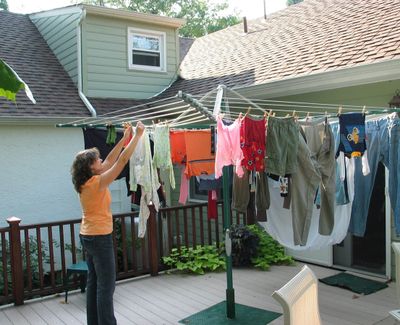Line Drying Makes Going Green a Breeze

Modern eco-consciousness is meeting our collective craving for simpler times in an unexpected place - at the backyard clothesline.
Despite decades of homeowners’ association moratoriums and the convenience of clothes dryers, the clothesline is coming back. Americans are now looking at the clothesline, or solar dryer, as a way to save money on energy and clothing replacement costs, and reduce their impact on the environment.
“In the early part of the 20th century, line drying was the only option and no one thought much about it,” says Gary Sutterlin of Breeze Dryer, a company that markets clotheslines updated for 21st century standards of convenience. “At the end of the 20th century, clothes dryers became popular. But renewed environmental consciousness - not to mention high utility costs and other financial considerations - now have many people opting to dry their clothes outdoors. It saves money and helps save the environment.”
Consider these facts in favor of line drying:- The electric dryer accounts for 5 to 10 percent of a household’s energy costs.
- There are more than 88 million dryers in the United States, according to the Association of Home Appliance Manufacturers. Each consumes about 1,079 kilowatt-hours of energy per household, emitting 2,224 pounds of carbon dioxide.
- Repeated mechanical drying can significantly shorten the wearable life of an article of clothing. Clothes dryers can cause shrinkage, pilling, stretching, pulls and static electricity.
- Across the country, homeowners are challenging homeowners’ association bans on clotheslines, blazing a trail for others to follow.
Convenience, long the big advantage of the electric clothes dryer, has significantly improved with line drying systems as well. Long gone are the days of two unattractive poles, sunk in the ground at opposite ends of the yard with several lines strung between them. Many modern line dryers are collapsible, retractable and designed to provide maximum utility in a minimum of space.
New line drying systems address appearance concerns and space constraints, making them a better fit for the suburban landscape. Yard-based rotary units now collapse. Other systems use a wall-hung unit to house retractable lines. Homeowners simply mount the units on the side of the house and stretch the lines to a discrete anchor point. When done, they can retract the lines back into the unit. Still another option is a wall-mounted frame that extends a few feet from the wall when in use, then folds down flat against the wall when you’re done with it. And expandable indoor units can do double duty on a deck or patio.
At www.breezedryer.com, Sutterlin’s company has introduced to the United States a line of outdoor laundry solutions that are hugely popular and widely used in Australia and New Zealand. Along with the expatriates from those countries who welcomed the availability of the products when the site launched in March, Sutterlin has seen surprising interest from Americans as well.
Americans, it seems, are also finding benefits beyond cost and energy savings, Sutterlin says. “We’re hearing that some people find sitting on their back deck and watching their rotary clothes dryer turn in the breeze to be very restful - like watching fish in a tank,” he says. Still others are turning hanging the clothes out into an opportunity for the family to spend some quiet time together in the fresh air. Plus, parents use line drying as a practical lesson in green living for their children.
Still, the bottom line does seem to be … the bottom line. Line drying saves money and it’s a “green” home improvement at a time when even the smallest eco-friendly improvement can add value to a home and one’s bottom line.
“In Australia and New Zealand, 90 to 95 percent of the population line-dry their laundry,” he says. “Here, Americans are viewing it as a very cost-effective green home improvement to install one of these systems.”
To learn more about line drying, visit www.breezedryer.com.